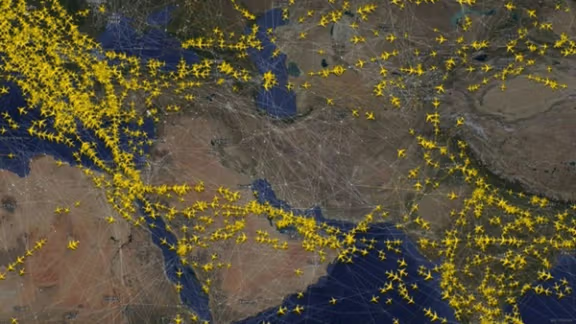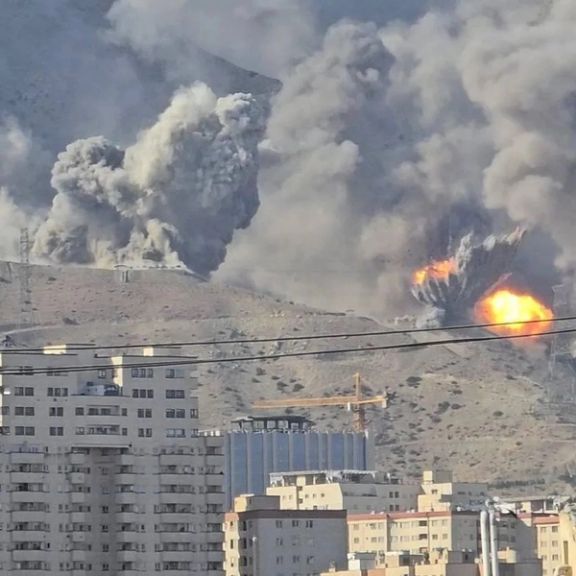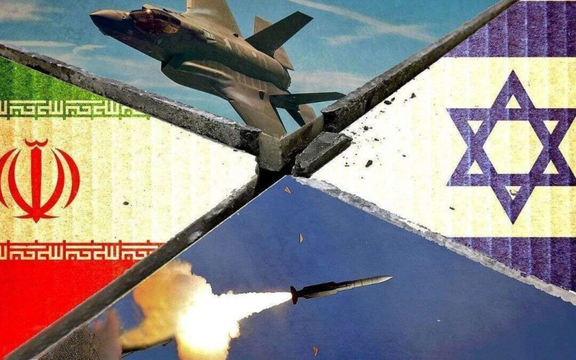Foreign flights to Iran drop 80 percent after war, data shows

Iran’s international air traffic has plunged to a fifth of pre-war levels, ten days after authorities reopened the country’s main airports following a ceasefire with Israel.
Iran International

Iran’s international air traffic has plunged to a fifth of pre-war levels, ten days after authorities reopened the country’s main airports following a ceasefire with Israel.
Iran officially reopened its airspace on July 3, saying all airports were fully operational.
Khomeini International Airport recorded just 25 takeoffs and landings on July 12, down from 118 on June 7, the Saturday before the June 13 Israeli strikes.
Mehrabad Airport in Tehran saw a similar drop, halving its total flights over the same period.
On June 7, Mehrabad Airport handled a total of 137 domestic flights. By July 12, nearly three weeks after the ceasefire, that number had dropped to just 70.
“A lot of domestic flights are being cancelled because the demand simply isn’t there,” a Mehrabad employee told Iran International. “People are still afraid their planes could be targeted. Everyone remembers the Ukrainian flight.”
In 2020, Iran’s Revolutionary Guards mistakenly shot down a Ukrainian passenger jet over Tehran, killing 176 people. Authorities later blamed “human error” in the air defense system.
Dramatic fall in regional and long-haul flights
International connections from Iran have collapsed since the war. Before the attack, Khomeini Airport saw routine flights to Europe and East Asia. By July 12, nearly all those routes had vanished.
What remains is a limited number of flights to regional countries, and even those have been sharply reduced.
Flights to Turkey, which had peaked at 42 on June 7, dropped to just five on July 12. Routes to Austria, Germany, Kazakhstan, Afghanistan, China, Thailand and India were eliminated entirely. UAE flights also fell from 19 to four.
Only 15 percent of flights at Khomeini Airport on July 12 were operated by foreign airlines, down from 46 percent a month earlier. European carriers like Lufthansa and Austrian Airlines, as well as major Persian Gulf operators including Emirates, Qatar Airways, and Pegasus, have all halted service and they did not any flights on July 12.
The domestic sector has tried to fill the vacuum. New or expanded operations were registered by Kish Air, Varesh, while others—like Mahan Air, Iran Air, Taban, and Yazd Airways—recorded no flights at all.
At Mehrabad, flights were only operating to 11 cities. The majority of former destinations—including Ahvaz, Isfahan, Tabriz, and Bushehr—no longer appeared on the boards.
Some domestic services appear to have shifted to more operational or government-linked destinations, including frequent flights to industrial or oil-rich areas such as Asaluyeh and Siri Island.
Opaque routes and missing data
Several recent flights had no listed origin or destination, raising questions about potential information blackouts or data suppression. Sources at Mehrabad suggested this may reflect either intentional concealment or failures in data processing since the war.
In other cases, regular routes had become effectively defunct. Flights from and to airports in Rasht, Yazd, Zahedan, Qeshm, Ahvaz and many others were no longer available, despite being active before the June 13 escalation.
“Some of these suspended routes were simply under-booked,” the Mehrabad staffer added. “Tickets were sold, but not enough people were willing to fly, so the flights got cancelled.”
Iran’s aviation sector, already under strain from sanctions and underinvestment, now faces another extended period of isolation—one increasingly reflected in the empty skies above.

Iran will deliver a "proportionate and appropriate response" if European parties move to re-activate the UN snapback mechanism to reinstate international sanctions removed under the 2015 nuclear deal, Foreign Ministry Spokesman Esmail Baghaei said on Monday.
"The so-called snapback mechanism has no legal or political basis," Baghaei said during his weekly press briefing. "In light of recent developments, resorting to such a mechanism is more unfounded than ever and lacks any legal, political, or ethical justification."
Baghaei stressed that Iran still considers itself a signatory of the Joint Comprehensive Plan of Action (JCPOA), despite reducing its commitments in response to what he described as "blatant violations" by the United States and European parties. The US pulled out of the 2015 agreement in 2018 under President Donald Trump's first administration.
“Our reduction of commitments was a response one year after the illegal withdrawal of the US from the JCPOA,” he said. “The European parties themselves also violated their obligations under the deal and failed to act accordingly. Therefore, they have no standing to invoke the mechanism.” He did not elaborate on how the EU violated the deal.
He said the move to activate the snapback clause, originally embedded in UN Security Council Resolution 2231, was "just an instrument of political pressure" and "will be met with a proportionate and appropriate response by Iran."
He dismissed the European threats as lacking "any legal justification" and said, "They must be held accountable for the consequences of their own failures. If they had adhered to their commitments honestly, today’s situation would have been different.”
Earlier in June, France’s Foreign Minister Jean-Noël Barrot said, “France, together with its European partners, can, with a simple letter, reimpose a global embargo on weapons, nuclear equipment, and banking and insurance sectors in Iran, which were lifted 10 years ago.”
Under UN Security Council Resolution 2231, any current JCPOA party—France, Germany, the UK, Russia, or China—can file a non-compliance complaint. If no resolution to maintain sanctions relief is adopted within 30 days, all previous UN sanctions automatically snap back, including cargo inspections, arms embargoes, and missile-related restrictions.
Iran accuses Germany of double standards
The spokesman also criticized Germany and the International Atomic Energy Agency (IAEA), alleging selective enforcement of nuclear non-proliferation obligations and supporting Israeli military actions.
“Germany’s hosting of US nuclear weapons is in clear violation of its obligations under the Non-Proliferation Treaty (NPT),” Baghaei stated. “We know that a significant number of US nuclear warheads are stationed in Germany, which itself is enough to show a breach of international commitments.”
He added, “Despite this, we witness Germany taking an incorrect stance and supporting violations of international law by backing Israeli military actions. This support carries international responsibility.”
Just days after Iran expelled the UN watchdog, Baghaei also accused the IAEA of "instrumental and selective behavior" in addressing nuclear issues, saying the agency has become part of a broader political toolset, in particular, giving information to the US and Israel which Iran says helped strikes launched against Iran's nuclear facilities last month.
Iran also criticized the IAEA for not condoning the strikes on the country's three main nuclear facilities. “The peaceful nuclear facilities of Iran are being targeted militarily, while the agency remains silent on clear violations by other countries,” he said.
On reports of Russia allegedly pushing Iran to agree to "zero enrichment" levels, Baghaei called the claims “fabricated” and aimed at “damaging Iran’s ties with its partners.” He said that “Russia knows well that Iran makes independent decisions regarding its nuclear policy, and they have always respected that.”
No date for talks, no proposals from allies
Regarding the resumption of nuclear negotiations, Baghaei said no time or location has been set for future talks but confirmed ongoing consultations with China and Russia.
“We maintain strategic relations with both countries and are in close contact with them,” he said. “While no specific proposals have been presented, both China and Russia have consistently expressed readiness to help resolve the nuclear issue.”
He cited “positive discussions” between Iranian and Russian officials during the recent BRICS summit and added that Foreign Minister Abbas Araghchi had traveled to China to attend the Shanghai Cooperation Organization ministerial meeting for continued consultations.
On reports that China or Norway may act as new intermediaries in nuclear negotiations, Baghaei said such rumors were “just speculation and cannot be confirmed.”
Diplomacy still an option, but not at any cost
When asked about Iran’s conditions for returning to talks, Baghaei said, “We are serious about diplomacy and have entered negotiations with good faith. However, before the sixth round of talks, the Zionist regime, in coordination with the United States, carried out a military aggression against Iran.”
He emphasized that Iran would not re-enter negotiations “until there is confidence in the effectiveness of diplomacy.”
“Diplomacy is a tool and an opportunity,” he said. “We are not allowed to deprive ourselves of this tool to explain Iran’s position and defend our national interests. Just as the armed forces are fulfilling their duty to defend the country, the diplomatic apparatus must do the same through diplomacy.”
Damage to Fordow still under review
Baghaei said that assessments of damage to Iran’s Fordow nuclear facility, targeted by US bombs just before the ceasefire with Israel last month, are still ongoing due to the "scale and type of the strikes."
He also responded to a recent joint statement by the UK, France, and Germany condemning Iran's retaliatory strike on the Al-Udeid air base in Qatar.
“It is the height of hypocrisy for the three European countries to justify the aggression of the Zionist regime and question Iran’s legitimate defensive response,” he said. “These statements are baseless and not worth responding to.”

Iranian state media have detailed an alleged Israeli strike on a Supreme National Security Council (SNSC) meeting in Tehran on June 16—but Iran International’s investigation reveals contradictions that cast doubt on the official narrative.
IRGC-affiliated Fars News reported on Saturday that a meeting of the SNSC was held on Monday morning, June 16 in one of the underground floors of a building in western Tehran.
According to the report, the meeting—attended by the heads of Iran’s three branches of power—was hit by six bombs or missiles, and President Masoud Pezeshkian and some other officials sustained minor leg injuries when trying to flee.
In response to Iran International’s inquiry on Sunday, the Israeli military declined to comment on the Fars report. Nevertheless, several aspects of the report can be subjected to fact-checking.
Time and location of the strike
Iran International reviewed reports of explosions in the capital on June 16 but found no evidence of six consecutive blasts occurring in Tehran that morning.
However, there is substantial evidence indicating that the alleged attack took place on Monday afternoon.
On June 24, Vahid Jalili, deputy head of Iran’s state broadcaster, said: “Last Monday [June 16], an hour before the strike on the IRIB, they [Israelis] hit the meeting of the heads of branches. Miraculously, they survived.”
The strike on IRIB’s glass building occurred at 6:34 PM Tehran time on June 16.
Assuming Fars may have misreported or misstated the time of the incident, Iran International investigated other explosions in western Tehran later that day.
Numerous video reports confirm that a site in Shahid Bagheri Town in western Tehran was hit by multiple missiles in the afternoon and evening of June 16. Iran International published two videos that same day showing the blasts in the area.
Additional footage posted on social media shows the explosions from various angles.
One social media user posted a photo on June 16, writing: “At 16:45, they hit the mountains next to Bagheri Town with at least seven bombs.”


While the area’s topography and lack of satellite imagery make it difficult to pinpoint the exact missile impact sites, Iran International’s analysis indicates the location was likely within the grounds of Dokooheh Hall, an IRGC facility located in the Chitgar area north of Bagheri Town.

Who was the target?
Meetings of the heads of the three branches—executive, judiciary, and legislative—are typically attended by the president, judiciary chief, and parliament speaker. These sessions are usually hosted by one of the three bodies, most often the president’s office, but sometimes by parliament or the judiciary.
Such meetings are usually held to coordinate on routine national matters and may also include ministers or senior security officials. Given the wartime context at the time, holding such a meeting does not appear particularly urgent or critical.
In contrast, meetings of the Supreme National Security Council are broader in scope.
In addition to the three heads of the branches, they include seven other official members: the foreign minister, intelligence minister, interior minister, head of the budget organization, chief of staff of the armed forces, army commander, and IRGC commander. Two representatives of Supreme Leader Ali Khamenei—Saeed Jalili and Ali Akbar Ahmadian—also attend.
On June 28, Khamenei's advisor Ali Larijani first revealed there had been an operation targeting the Supreme National Security Council on June 16.
“They had discovered the meeting of the heads of branches and wanted to eliminate them through bombing, but they failed,” Larijani said. “The plan was to wipe out the country’s leadership and then move on to the Supreme Leader and dismantle the Islamic Republic.”
Former IRGC chief-commander Mohsen Rezaei made similar remarks in a television interview on July 9, saying: “They couldn’t hit the Supreme Leader. They bombed the Security Council's meeting—six points of the location were struck, but not a single member was harmed.”
Was Pezeshkian the intended target?
Without access to classified information, such claims remain speculative. However, the Israeli news outlet Ynet, citing Danny Citrinowicz—a researcher and former head of the Iran desk at Israeli military intelligence—wrote that Pezeshkian is considered a reformist and was unlikely to have been the primary target.
Citrinowicz said that Pezeshkian currently chairs the Supreme National Security Council, and since the council can significantly influence Iran’s national security decisions, the meeting itself may have been the intended target.
One day after the strike, Iran International obtained information showing that in an unprecedented move, Ali Khamenei had delegated a substantial portion of his authority to the Supreme Guard Council.
What did Netanyahu and Trump say on June 16?
At approximately 7:00 PM Tehran time on June 16, Israeli Prime Minister Benjamin Netanyahu told ABC News that targeting Khamenei was not off the table. He emphasized that such an action “would not escalate the conflict but end it.”
Asked directly whether Israel would strike Khamenei, Netanyahu said: “We will do whatever is necessary.”
Donald Trump, who was attending the G7 summit in Canada, left the event unexpectedly a day early on June 16.
Politico reported the same day that Trump abruptly left the G7 summit after expressing concern about escalating conflict between Iran and Israel. At the time, French President Emmanuel Macron said Trump had left to work on a ceasefire plan between Israel and Iran.
On Tuesday, June 17, Trump rejected that claim on Truth Social, writing: “Wrong!” he wrote. “He has no idea why I am now on my way to Washington, but it certainly has nothing to do with a Cease Fire. Much bigger than that.”
Iran probing insider role
Iran has launched a wide-ranging investigation into Israel’s attempted assassination of President Masoud Pezeshkian, with suspicions of an inside agent, Al Jazeera reported on July 13, citing an unnamed senior Iranian official.
“The assassination attempt on President Pezeshkian will not go unanswered — Israel will pay the price,” the official was quoted as saying.
“Israel deliberately targeted the Iranian president during an important National Security Council meeting during the war,” the official added.
In addition to the president, the official said the operation targeted “the heads of the executive, legislative, and judicial authorities,” describing it as part of “an Israeli plan aimed at overthrowing the regime in the country.”

More than 400 senior clerics in Iran’s holy city of Qom have backed a religious decree labeling threats against Supreme Leader as “moharebeh” or “waging war against God,” a crime in Islamic law that can carry the death penalty.
The members of the Society of Seminary Teachers of Qom, many of whom are senior religious scholars in Iran’s influential Shi’ite seminaries, said they were endorsing a fatwa which declared those who threaten religious authority figures – including the Supreme Leader – fall into the category of mohareb and must face the corresponding religious and legal consequences.
The clerics did not cite a specific decree, referring only to a “sensitive, historic, and courageous fatwa” by senior religious authorities in Qom and Najaf. Two recent fatwas by Grand Ayatollah Hossein Nouri Hamedani and Nasser Makarem Shirazi align with this description. The fatwas were issued in response to remarks by Israeli officials about assassinating Ali Khamenei.
“The Supreme Leadership and the institution of religious authority are symbols of the dignity of the Islamic Ummah,” the clerics said in the statement published by the IRGC-affiliated Fars News Agency. “Threats against them are threats against the foundations of Islam itself.”
“This fatwa is necessary and timely,” the Qom-based clerics wrote. “Defense of religious leadership is a duty for all Muslims.”
The signatories include prominent figures such as Ahmad Khatami and Alireza Arafi, both members of Iran’s Guardian Council, as well as senior clerics from the Qom seminary, many of whom hold official or semi-official posts in Iran’s establishment.
Iran has a history of issuing religious rulings with international consequences, most notably the 1989 fatwa by Ayatollah Ruhollah Khomeini calling for the killing of British author Salman Rushdie. That fatwa remained in place for decades and was widely cited after a 2022 knife attack on Rushdie in New York.
Grossi in crosshairs
In their joint statement, the clerics called for the prosecution of several international figures, including US President Donald Trump, Israeli Prime Minister Benjamin Netanyahu, and International Atomic Energy Agency (IAEA) Director General Rafael Grossi, accusing them of being “war criminals” complicit in attacks on Iranian leadership and infrastructure.
“We demand that international courts try and punish Grossi, Trump, Netanyahu, and all those who have betrayed humanity,” the clerics said.
The call for prosecuting Grossi comes amid growing hostility between Tehran and the UN nuclear watchdog following the recent Iran-Israel war.
Iranian authorities have accused Grossi and the IAEA of facilitating attacks on Iranian nuclear sites through what they call “deceptive inspections” and “intelligence sharing” with hostile governments.
“The IAEA has acted not as a neutral body but as a tool of Western espionage,” said cleric-turned-lawmaker Mahmoud Nabavian last week, alleging that inspectors had smuggled surveillance equipment into nuclear facilities. “They are spies disguised as inspectors, and Mr. Grossi is fully complicit.”
On Wednesday, Ali Mozaffari, deputy head of Iran’s judiciary, said Iran was considering trying Grossi in absentia for allegedly enabling Israeli strikes on Iranian nuclear facilities. Mozaffari said the judiciary was compiling evidence of “foreign aggression” and would pursue legal remedies.
Hardline media outlets, including Kayhan newspaper — closely aligned with Khamenei — have called for Grossi’s arrest and even his execution should he travel to Iran.
Western governments have condemned the threats against Grossi. Britain, France, and Germany released a joint statement last month expressing “full support for the independence and impartiality of the IAEA” and warning Tehran against politicizing the agency’s work.

Israel sought to bring about regime change in its 12-day war with Iran, but its failure to achieve that goal proves Tehran won the conflict, a senior Iranian official said on Sunday.
“The Zionist regime’s goal was not limited to nuclear facilities and the nuclear program... They were certainly pursuing broader strategic objectives — seeking regime change and the collapse of the system and structure,” said Kazem Gharibabadi, Iran’s deputy foreign minister for legal and international affairs.
Speaking in a televised interview, Gharibabadi said Israel did not achieve its strategic goals as it failed to topple Iran’s ruling system, arguing that the war’s outcome should be judged by objectives met, not battlefield damage.
“If we look at the issue from this angle — that this was the key strategic goal of the Zionist regime — then assessing who won or lost in this war cannot be based on casualty numbers, buildings destroyed, or damaged infrastructure,” he said.
“You have to ask whether either side achieved its strategic objectives.”
Last month, Israeli Prime Minister Benjamin Netanyahu said his country's military campaign against Iran was giving its people a chance to topple the Islamic Republic.
"A light has been lit—carry it to freedom,” Netanyahu told Iran International's anchor Pouria Zeraati on June 16. “This is the time. Your hour of freedom is near—it’s happening now.”
Netanyahu framed Israel’s campaign as both a defensive war and an opportunity for the leadership in Tehran to be overthrown. “This is evil against good, and it's time for good people to stand up with the good, the good people of Iran, and good people everywhere against this madness foisted on all of us by this radical tyranny. It's about to end."

The Iranian parliament's national security and foreign policy committee has approved the general provisions of a draft bill aimed at boosting the country’s armed forces against the Israeli threat, a senior Iranian lawmaker said on Sunday.
"The general outlines of the bill to strengthen the armed forces in comprehensive confrontation with the crimes and aggressions of the Zionist regime were approved,” committee spokesman Ebrahim Rezaei was quoted as saying by Iranian media.
Rezaei added that the bill was referred to the committee’s defense subcommittee for further review.
According to Rezaei, the bill—introduced by Tehran MP Ali Khezrian—has so far secured the backing of 120 members of the parliament.
Rezaei said the bill was discussed on Sunday during a meeting attended by representatives from the defense ministry, the armed forces general staff, the army, and the Revolutionary Guards (IRGC).
He added that the deputy defense minister told the committee the ministry was working to secure increased funding to meet the country’s defense requirements.
Iran's government spokesperson announced a 200% increase in the military budget in October 2024, saying that the purpose of the move was to "strengthen the country's defense capabilities."
The budget for Iran’s armed forces was 7,220 trillion rials in last year’s budget bill. Given the exchange rate defined in that budget (330,000 rials per dollar), Iran’s military budget last year could be estimated at $15.7 billion.
Based on this, the allocated budget for Iran’s armed forces in the coming year could be estimated at $46 billion.





